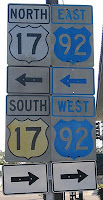
I'm been going down the same road for awhile. The road of querying agents, trying to get one to consent to represent me. And now I've begun to consider two new roads, one for novels and one for short stories.
Recently I believe I came about as close as I'm going to get. I've gotten some turndowns lately that make me think this is the end of this road. Not because the agent didn't like my work, but because she did. One agent liked my work very much, but didn't know where she could sell it. Another agent liked the project also, but didn't know what market it would fit, which is about the same thing, I think.
Discouraged by these rave rejections, I sent a couple of manuscripts to a small press that I admire. I admire them because they're putting out some pretty darn good books. True, I know some of the authors, but, because of that, I've bought and read some of the books. They're well put together, well edited, good covers, and the agent has submitted at least some of the authors for awards. I know this because they've won these awards. I plan on buying some by authors I don't know.
I'm well aware of the pitfalls of a small press, but I'm considering them against the pitfalls of a large, traditional publishing house, for which you need an agent, something I don't yet have. And may never have. The following is a post I made on a small list earlier today that prompted me to do further thinking about this, and this blog.
I've stopped to think it through. Do I really WANT an agent? An agent will try to sell to an editor at a publishing house. Maybe with success, maybe without. Then I'll be nowhere. If a sale is made, then what? I get a small advance, $5000 is the most I can hope for. If I don't spend at least twice that amount on promotion (and maybe even if I do), if I don't sell an awful lot of books, I won't earn their money back for them. Then I'll be dropped and I'll be nowhere.
There too many paths that lead right back to where I am now. So I'm looking for a new path, as I think a lot of writers are. I'm querying small presses, just beginning with this in a serious way, and would be ecstatic to be printed by one. I would be much more likely to keep getting books printed, especially if I'm not printed in hardcover, but trade paperback or ebook. I'm sure I could get dropped by a small press, too, but it's much more likely that the small press will fold on me. The latter would not be a good thing, and I might even have trouble getting my rights back, but it wouldn't damage my name like all the dead ends in the traditional world. The former, being dropped, would probably be the same as being dropped by a big press. I'd have to change my name and start over.
I'm also exploring the option of putting my short stories out myself. I'm gathering intell from people who have done this and just met a guy Monday who has put out 5 books with Smashwords and offered to steer me through the process. Other writer friends have encouraged me to do it, too. There would be NO downside to this. No one would drop me. I would print or sell electronically as many as I could, of course, and would promote as much as I can, but wouldn't be terrified that my publisher would drop me because I wouldn't have one, except myself. And if I could get a following for my short stories, I might just get a following for my novels, too. Another upside.
If this reasoning is faulty, someone please point it out! I'm deep into the considering stage at the moment and could be easily swayed.

